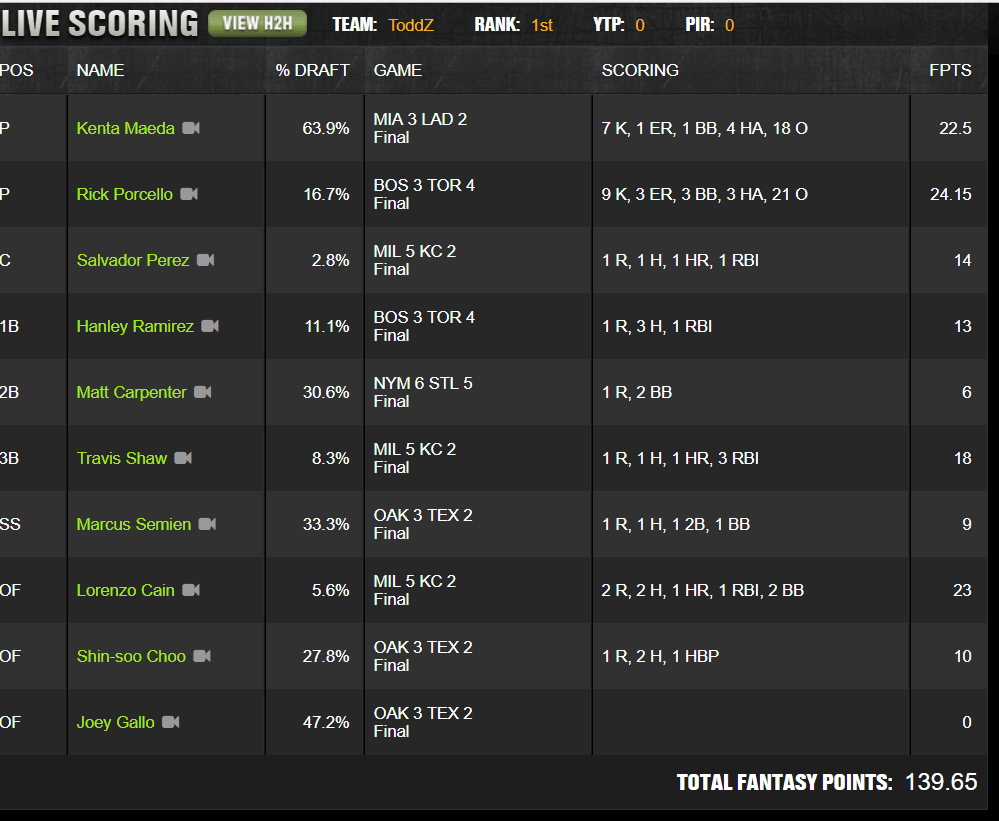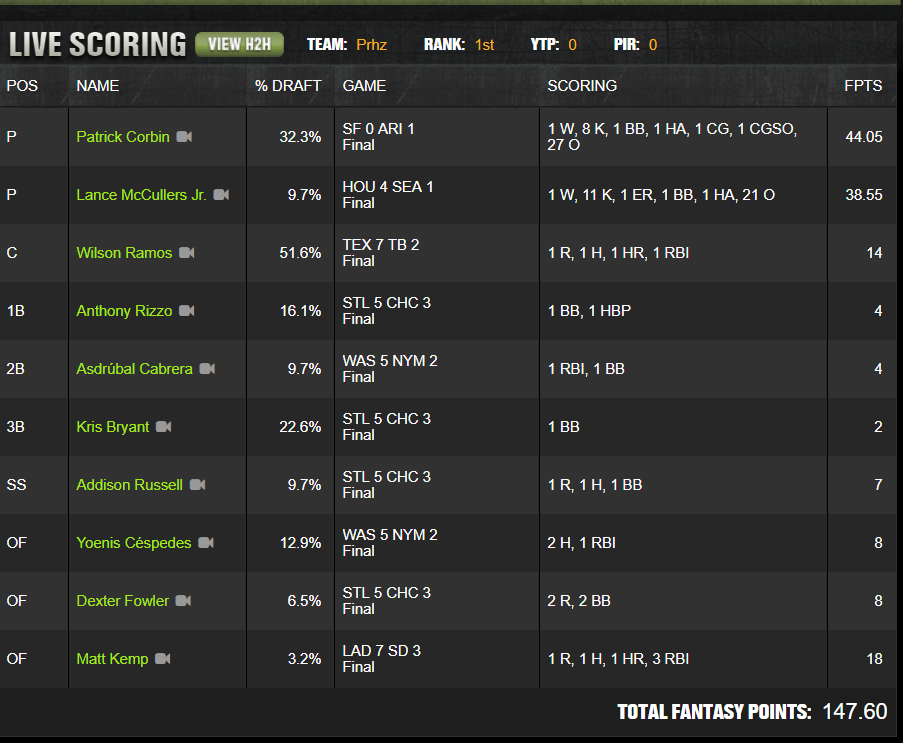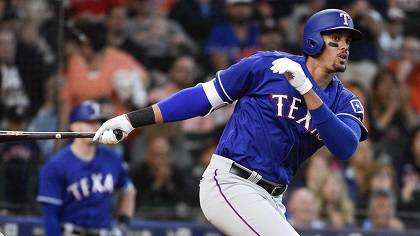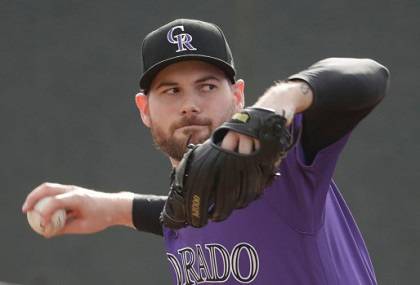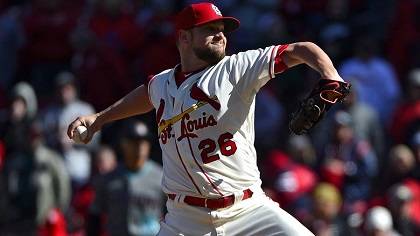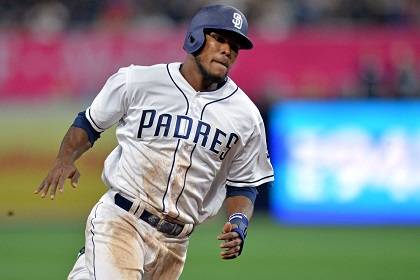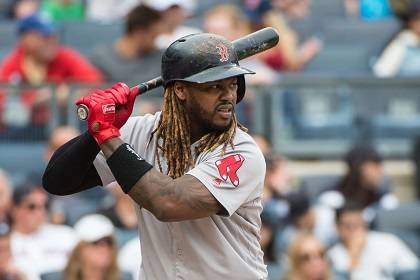Welcome to the weekly Tout Wars FAAB report, on its new home right here on the Tout Wars site. Each week, we’ll review the free agent acquisitions from all five leagues, with commentary from a league member, as well as yours truly. We changed the timing of the weekly run to 1 PM ET every Sunday, with the report posted later that afternoon so you’ll have time to digest and apply to your own leagues. In addition, I’ll be joining Lawr Michaels and Justin Mason on the Tout Wars Hour on the FNTSY Network every Sunday at 3:20 PM ET to discuss the results.
You can find the complete list of Tout Warriors here. Everyone starts with 1000 FAAB units, less any penalty incurred by finishing below a designated point in the standings. This is a means of keeping everyone motivated to keep playing all season long. The minimum bid is $0. FAAB units can be traded as well as rebated for players released off the DL.
The report will list all winning bids along with unsuccessful tries and contingencies. This provides the maximum level of information to help gauge interest on the players.
The American and National League only formats are 12-team leagues, as is the new points-based head to head league, The Mixed Auction and Draft each have 15 clubs. All the leagues have four reserves with an unlimited DL, expect the head to head league, which allows six reserves.
The headings above each league are links to publicly accessible sites where you can see standings, roster and a complete review of transactions. The initial auctions and drafts can be found here.
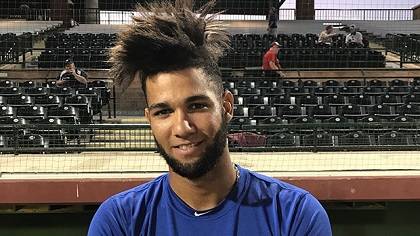
AMERICAN LEAGUE
SUCCESSFUL BIDS
| PLAYER |
WINNING BID |
|
|
| LGurriel, Tor |
Vlad Sedler 159 |
Seth Trachtman 122 |
Patrick Davitt 39 |
|
|
Rob Leibowitz 16 |
|
| BColon, Tex |
Doug Dennis 11 |
Lawr Michaels 0 |
|
| RNunez, Tex |
Rob Leibowitz 9 |
Vlad Sedler 29 |
Lawr Michaels 5 |
|
|
Rick Wolf/Glenn Colton 1 |
|
| JDiekman, Tex |
Chris Liss 5 |
|
|
| JPeterson, NYY |
Rob Leibowitz 4 |
|
|
| LMaile, Tor |
Lawr Michaels 3 |
|
|
| TraThompson, CWS |
Seth Trachtman 1 |
Rob Leibowitz 2 |
Rick Wolf/Glenn Colton 1 |
| ChMartin, Tex |
Rick Wolf/Glenn Colton 1 |
Doug Dennis 0 |
|
| HHembree, Bos |
Rick Wolf/Glenn Colton 1 |
Doug Dennis 0 |
|
| RGrossman, Min |
Rick Wolf/Glenn Colton 1 |
Seth Trachtman 1 |
|
| JField, TB |
Rick Wolf/Glenn Colton 1 |
Rob Leibowitz 4 |
|
| JBarria, LAA |
Seth Trachtman 1 |
|
|
| DOtero, Cle |
Doug Dennis 0 |
|
|
| TClippard, Tor |
Lawr Michaels 0 |
|
|
| DFreitas, Sea |
Lawr Michaels 0 |
|
|
| EGonzalez, Cle |
Seth Trachtman 0 |
|
|
| RPressly, Min |
Doug Dennis 0 |
|
|
UNAWARDED BIDS
| PLAYER |
|
|
|
| MHernandez, Bos |
Rob Leibowitz 3 |
|
|
| BRondon, CWS |
Rick Wolf/Glenn Colton 1 |
|
|
| NGoody, Cle |
Rick Wolf/Glenn Colton 1 |
|
|
| RLaMarre, Min |
Rick Wolf/Glenn Colton 1 |
|
|
| TOaks, KC |
Seth Trachtman 1 |
|
|
| CRoe, TB |
Rick Wolf/Glenn Colton 0 |
|
|
| GUrshela, Cle |
Rob Leibowitz 0 |
|
|
| JKelly, Bos |
Lawr Michaels 0 |
|
|
| JPazos, Sea |
Doug Dennis 0 |
|
|
| LSardinas, Bal |
Seth Trachtman 0 |
|
|
Glenn Colton’s Commentary
There were not a lot of fish in the free agent sea for this week’s Tout Wars AL FAAB fishermen. Yuli Gurriel’s baby brother Lourdes Gurriel was the big catch when the AL Tout Warriors cast their lines. Vlad Sedler now owns Gurriel thanks to a big $159 bid. While Vlad may end being right about his faith in the Jays MI, his fellow owners did not agree Gurriel was worth it. Indeed, only one other owner bid (Patrick Davitt at $39). Gurriel has made starts at 2b and SS for the Jays since being called up earlier in the week so there should be playing time while Josh Donaldson and Troy Tulowitzki are on the shelf. Last year Lourdes struggled in the minors, posting a mere .241 at Double-A but this year in his second go at the level, he raked .347. In this author’s view, Lourdes Gurriel is a deep-leaguer only as there is little evidence he will contribute much speed or power this year.
Other hitters who went off the board were a selection of guys who were needed mostly to fill holes. For example, our team, Colton & the Wolfman, found itself very short on OF, so we went fishing in the shallow end and reeled in Johnny Field and Robbie Grossman for $1 each. Hopefully they will not be needed for very long.
The ageless wonder, Big Sexy himself, Bartolo Colon, was the big pitching fish going for $11 to pitching guru Doug Dennis. As for us, team Colton & the Wolfman cut bait on some bad starting pitching choosing instead to roster high K relievers Heath Hembree and Chris Martin – both of whom have pitched pretty well thus far this year.
Bottom line: with 8 of the 12 Tout AL teams having 900+ of their 1,000 FAAB still in the bank, it seems owners are trying to position themselves for a run at the midsummer interleague trade talent.
Todd’s Take
I’ve been intrigued by Chris Martin since the spring. The Rangers bullpen is still a bit unsettled with Keone Kela currently copping closing duties. He’s getting by, but not without issued. Kela’s first pitch strike, and overall strike rates are well below league average, especially for a closer.
Martin spent the last couple seasons in Japan, refining his stuff. It seems to have worked as the lanky righty has fanned 10 with just two walked in 10.1 innings. Hit and homers have been an issue, but I’d rather have the solid K and BB skills and hope for regression than rely on a guy with a low BABIP and mediocre skills.
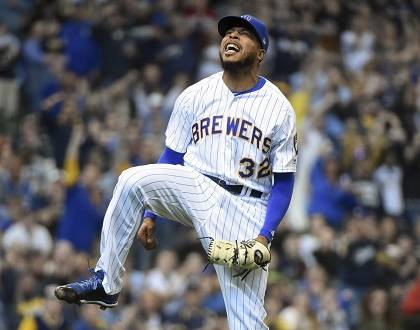
NATIONAL LEAGUE
SUCCESSFUL BIDS
| PLAYER |
WINNING BID |
|
|
| JJeffress, Mil |
Todd Zola 77 |
Steve Gardner 22 |
Scott Wilderman 1 |
| TBlach, SF |
Lenny Melnick 67 |
Tristan H. Cockcroft 0 |
|
| ABlandio, Cin |
Brian Walton 40 |
Scott Wilderman 12 |
|
| ACimber, SD |
Todd Zola 37 |
Steve Gardner 10 |
Scott Wilderman 0 |
| MWisler, Atl |
Phil Hertz 34 |
Tristan H. Cockcroft 3 |
Grey Albright 1 |
| TONeill, StL |
Todd Zola 33 |
Brian Walton 25 |
Mike Gianella 13 |
|
|
Tristan H. Cockcroft 12 |
Scott Wilderman 1 |
|
|
Steve Gardner 0 |
|
| MMuncy, LAD |
Brian Walton 30 |
Andy Behrens 1 |
|
| JNottingham, Mil |
Todd Zola 27 |
|
|
| JBautista, Atl |
Mike Gianella 22 |
|
|
| EDiaz, Pit |
Phil Hertz 13 |
Todd Zola 17 |
|
| ELauer, SD |
Lenny Melnick 9 |
Tristan H. Cockcroft 3 |
Phil Hertz 5 |
| DBote, ChC |
Craig Mish 8 |
|
|
| NCuevas, Col |
Grey Albright 5 |
|
|
| KTomlinson, SF |
Andy Behrens 4 |
Scott Wilderman 0 |
|
| JHellickson, Was |
Tristan H. Cockcroft 3 |
Phil Hertz 7 |
|
| JLobaton, NYM |
Grey Albright 1 |
|
|
| KCrick, Pit |
Steve Gardner 0 |
|
|
UNAWARDED BIDS
| PLAYER |
|
|
|
| PSewald, NYM |
Todd Zola 43 |
|
|
| VArano, Phi |
Todd Zola 37 |
Phil Hertz 3 |
|
| SCarle, Atl |
Todd Zola 33 |
|
|
| BDuensing, ChC |
Todd Zola 27 |
|
|
| JChargois, LAD |
Todd Zola 23 |
|
|
| JMurphy, Ari |
Todd Zola 23 |
Grey Albright 1 |
|
| MMoroff, Pit |
Brian Walton 20 |
Andy Behrens 1 |
|
| TTelis, Mia |
Brian Walton 20 |
|
|
| TNido, NYM |
Todd Zola 17 |
Grey Albright 1 |
|
| MKoch, Ari |
Phil Hertz 17 |
|
|
| CPerez, Atl |
Todd Zola 13 |
|
|
| ERamos, Phi |
Phil Hertz 3 |
|
|
| LGarcia, Phi |
Phil Hertz 3 |
|
|
| PMaton, SD |
Phil Hertz 3 |
Grey Albright 1 |
|
| CGearrin, SF |
Grey Albright 1 |
|
|
| JHughes, Cin |
Grey Albright 1 |
|
|
| PBaez, LAD |
Grey Albright 1 |
|
|
| CPennington, Cin |
Andy Behrens 1 |
|
|
| WChen, Mia |
Tristan H. Cockcroft 0 |
|
|
Todd’s Commentary and Take
I was the most active bidder, along with submitting the high bid, so I’ll pull double-duty this week. Anchored by Robbie Ray and Luis Castillo, my pitching isn’t off to a great start. Plus, I lost Taijuan Walker, though I get $110 FAAB units back for my $11 auction purchase.
I have faith things will get better, but the bleeding needs to be stopped by jettisoning Kyle Freeland and Brian Mitchell. I still like Mitchell, so he’ll be reserved, but Freeland is off the roster. The replacements are Jeremy Jeffress and Adam Cimber.
Cimber is getting the job done, pitching a decent number of innings with strikeouts. With Petco Park at his back, I’ll take my chances.
This just in – Craig Counsell doesn’t care about your (or my) fantasy team. I’m at the point I suspect he asks his relievers to pick a number 1 to 100 and whichever is closest gets to close that night. I don’t need saves with three closers (Brad Boxberger, Brandon Morrow and Arodys Vizcaino but maybe another save or two from Jeffress will facilitate a trade down the line. My bigger concern is innings and whiffs, which he’s providing.
Needing someone to replace Walker, I opted for a stick since I was using an arm in the swing spot. I have no idea how much Tyler O’Neil will play, but there’s no reason to be miserly with FAAB since I’m playing with the short stack. As it turns out, I could have just activated David Dahl into swing, but I’m OK with using both Dahl and O’Neill while sending Juan Lagares to the bench.
On draft day, securing Stephen Vogt and Manny Pina on the cheap seemed genius. The best laid plans. Pina is due back, but I wanted a hedge. Nottingham is perfect since he’ll play even when Pina is back plus if Pina doesn’t make it back, Nottingham will play even more. Tout rules allow mid-week activation of players coming off the DL so long as you release the active player he replaces. With Jeff Mathis as my second catcher, I’m not concerned.
Enough about me…
Lenny Melnick is hoping Ty Blach takes advantage of a two-start week at home in AT&T and the Giants entertain a couple of last season’s NL playoff clubs with the Nationals and Dodgers coming to town. Both lineups are dangerous, but sluggish to open the season. Aiding Blach’s cause is Anthony Rendon finally hitting the DL over the weekend.
The Reds have been scuffling for s fill-in at the hot corner while Eugenio Suarez is on the shelf. Too bad they don’t have a can’t-miss third baseman prospect in the wings. Cliff Pennington got first shot, now it’s Alex Blandino’s turn. Brian Walton hopes Blandino can continue his modest three-game hitting streak.

MIXED LEAGUE AUCTION
SUCCESSFUL BIDS
| PLAYER |
WINNING BID |
|
|
| MWilliamson, SF |
Fred Zinkie 94 |
Ron Shandler 57 |
Tim McLeod 43 |
|
|
Al Melchior 13 |
|
| TCahill, Oak |
Jeff Zimmerman 54 |
Al Melchior 37 |
Ron Shandler 11 |
|
|
Bret Sayre 6 |
|
| MCanha, Oak |
Jeff Zimmerman 54 |
Ron Shandler 37 |
Al Melchior 0 |
| JJones, Det |
Ron Shandler 47 |
Bret Sayre 16 |
Fred Zinkie 13 |
|
|
Al Melchior 1 |
|
| CBettis, Col |
Fred Zinkie 43 |
Al Melchior 15 |
Tim McLeod 1 |
|
|
Jeff Zimmerman 0 |
|
| DSpan, TB |
Fred Zinkie 43 |
Bret Sayre 16 |
|
| MMoreland, Bos |
Zach Steinhorn 43 |
|
|
| JVargas, NYM |
Scott Engel 41 |
Fred Zinkie 23 |
|
| BColon, Tex |
Scott Engel 31 |
Scott Engel 33 |
Ron Shandler 3 |
| LGurriel, Tor |
Al Melchior 27 |
|
|
| AFrazier, Pit |
Ray Flowers 17 |
|
|
| ACashner, Bal |
Al Melchior 15 |
|
|
| MWisler, Atl |
Ron Shandler 11 |
Jeff Zimmerman 0 |
|
| AAlmora, ChC |
Tim McLeod 11 |
Al Melchior 1 |
|
| TomHunter, Phi |
Tim McLeod 8 |
|
|
| AWainwright, StL |
Bret Sayre 6 |
Jeff Zimmerman 0 |
|
| SRodriguez, Pit |
Ron Shandler 5 |
|
|
| BPhillips, Mil |
Ron Shandler 2 |
|
|
| JBandy, Mil |
Scott Pianowski 0 |
|
|
| EHernandez, LAD |
Bret Sayre 0 |
|
|
UNAWARDED BIDS
| PLAYER |
|
|
|
| AdGonzalez, NYM |
Zach Steinhorn 32 |
|
|
| JarGarcia, Mia |
Scott Engel 31 |
Tim McLeod 5 |
|
| MKoch, Ari |
Scott Engel 21 |
|
|
| MFiers, Det |
Scott Engel 19 |
|
|
| SPearce, Tor |
Fred Zinkie 13 |
|
|
| YHirano, Ari |
Tim McLeod 7 |
|
|
| JTomlin, Cle |
Bret Sayre 6 |
Jeff Zimmerman 0 |
|
| RDavis, Cle |
Tim McLeod 3 |
|
|
| JFields, LAD |
Tim McLeod 2 |
|
|
| HBader, StL |
Ron Shandler 1 |
|
|
| JHammel, KC |
Ron Shandler 1 |
|
|
| JProfar, Tex |
Ron Shandler 1 |
|
|
| NHundley, SF |
Scott Pianowski 0 |
|
|
| PSewald, NYM |
Scott Engel 0 |
|
|
| CFulmer, CWS |
Jeff Zimmerman 0 |
|
|
| KFreeland, Col |
Jeff Zimmerman 0 |
|
|
| MMoore, Tex |
Jeff Zimmerman 0 |
|
|
| SRomano, Cin |
Jeff Zimmerman 0 |
|
|
| TBlach, SF |
Jeff Zimmerman 0 |
|
|
| JCamargo, Atl |
Al Melchior 0 |
|
|
Jeff Zimmerman’s Commentary
It was a bland week for bidding in the mixed auction league. Most teams were just filling needs with Williamson, Canha, Jones, and Span in the outfield. For starters, Cahill, Bettis, Vargas, and Colon were the top bids. Toronto prospect, Lourdes Gurriel was taken for just $27. No one was too aggressive. The one move I like a little further down the list is Adam Frazier at $17. Frazier should slot right into DLed Josh Harrison’s role with the Pirates
With the 2nd and 3rd highest bids, I picked up Mark Canha and Trevor Cahill. While I overbid a bit on each one, I wanted them both, so I got them. With Cahill, I’m getting two starts from a pitcher who dominated the White Sox (whoopie). I know he could hurt my ratios but since I’m last in both ERA and WHIP, I might as well roll the dice with him.
With Canha, I’m hoping he’s as productive as he was in 2016. With hitters, I find they are already owned before owners can be 100% sure the breakout is legit. I’ll own him first and then see if his gains in plate discipline and hard contact stick.
Todd’s Take
Could Mac Williamson be the next entry into the Launch Angle Club? I’d ask him, but the first rule of the…you know the rest.
Williamson spent time with Doug Latta in the off-season. Previously, Latta refined Justin Turner’s approach and stroke and so far, it appears Williamson’s time was well spent. He slashed an eye-popping .487/.600/.1.026 top open the season at Triple-A Sacramento, forcing the Giants hand. There’s an opening with Hunter Pence out, but it wouldn’t take much for Williamson to secure playing time when Pence returns.
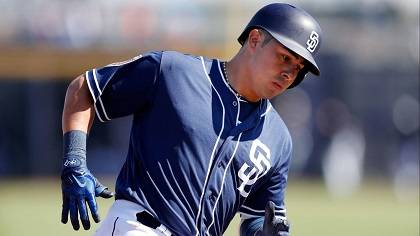
MIXED LEAGUE DRAFT
SUCCESSFUL BIDS
| PLAYER |
WINNING BID |
|
|
| ChVillanueva, SD |
Scott White 104 |
Michael Beller 78 |
Anthony Perri 56 |
|
|
Rudy Gamble 23 |
D.J. Short 22 |
|
|
Tom Kessenich 6 |
|
| JFields, LAD |
Anthony Perri 53 |
|
|
| JJones, Det |
Tom Kessenich 36 |
Perry Van Hook 6 |
|
| MWilliamson, SF |
Scott White 34 |
Scott White 64 |
Joe Pisapia 26 |
|
|
Greg Ambrosius 13 |
|
| BMcCarthy, Atl |
Michael Beller 33 |
D.J. Short 20 |
Greg Ambrosius 13 |
|
|
Jeff Boggis 12 |
Perry Van Hook 11 |
|
|
Adam Ronis 8 |
Scott White 0 |
| TWilliams, Pit |
Anthony Perri 32 |
|
|
| MWisler, Atl |
Anthony Perri 23 |
Perry Van Hook 3 |
|
| FGalvis, SD |
Gene McCaffrey 18 |
Tom Kessenich 2 |
|
| TCahill, Oak |
Greg Ambrosius 17 |
Joe Pisapia 34 |
Scott White 0 |
| RFlaherty, Atl |
Jeff Boggis 12 |
Tom Kessenich 3 |
|
| CBettis, Col |
Jeff Boggis 12 |
Jeff Boggis 11 |
Perry Van Hook 7 |
| AWainwright, StL |
Jeff Boggis 10 |
|
|
| BNimmo, NYM |
Greg Ambrosius 9 |
|
|
| DSpan, TB |
Perry Van Hook 7 |
Tom Kessenich 13 |
|
| JPederson, LAD |
Ray Murphy 4 |
|
|
| AdGonzalez, NYM |
Tom Kessenich 4 |
|
|
| JJimenez, Det |
Adam Ronis 4 |
|
|
| CSpangenberg, SD |
Rudy Gamble 3 |
|
|
| PSeverino, Was |
Anthony Perri 2 |
|
|
UNAWARDED BIDS
| PLAYER |
|
|
|
| AAlmora, ChC |
Joe Pisapia 6 |
|
|
| SPearce, Tor |
Tom Kessenich 4 |
Perry Van Hook 2 |
|
| MBoyd, Det |
Adam Ronis 4 |
|
|
| HPerez, Mil |
Gene McCaffrey 3 |
|
|
| MCanha, Oak |
Perry Van Hook 2 |
|
|
| PAlvarez, Bal |
Tom Kessenich 2 |
|
|
| CAsuaje, SD |
Gene McCaffrey 1 |
|
|
| JJay, KC |
Rudy Gamble 1 |
|
|
Ray Murphy’s Commentary
A lot of activity today in Mixed-Draft, with 12 of 15 teams working the free agent pool. But it’s mostly speculative plays or tweaking around the roster edges, as we had only one triple-digit bid (Christian Villanueva, won by Scott White with a bid of 103), and only one more over 50 (Josh Fields, won by Anthony Perri for 53). The other 17 players were all acquired for 36 units or less.
My acquisition was Joc Pederson. I was in the market for some OF depth, with Byron Buxton and Carlos Gonzalez banged up, and Wil Myers not yet OF-eligible. Pederson got some more playing time this week and showed some signs of life at the plate. Most noteworthy is that, so far, he is carrying over his late-2017 gains in contact rate. If that trend holds, he could work his way back into regular AB in the still-crowded Dodger OF.
Todd’s Take
If you don’t subscribe to The Athletic, think about it, if only to get Eno Sarris’ work (there’s other great stuff as well). It’s Eno’s story to tell, but this week, he featured six pitchers with a new weapon, one being Brandon McCarthy throwing what he calls a second slider, along with a curve and cutter. The differences in velocity, break and depth are working. With McCarthy’s injury history, get in while the getting’s good.
I’d be willing to bet half what’s left of my FAAB Wiseguy Gene McCaffrey bid on Freddy Galvis for his early week visit to Coors Field. As a challenge game player, Gene is wired to look for these sorts of things. You should too.
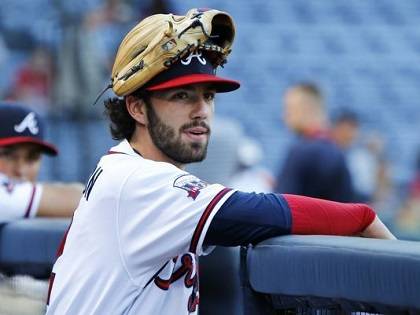
HEAD-TO-HEAD MIXED AUCTION
SUCCESSFUL BIDS
| PLAYER |
WINNING BID |
|
|
| DSwanson, Atl |
Stephania Bell 127 |
Michael Rathburn 36 |
Andrea LaMont 31 |
| ChVillanueva, SD |
Michael Rathburn 56 |
Paul Sporer 36 |
Peter Kreutzer 23 |
|
|
Justin Mason 5 |
Jake Ciely 2 |
| MWisler, Atl |
Andrea LaMont 41 |
Peter Kreutzer 37 |
|
| TRoss, SD |
Jake Ciely 39 |
Peter Kreutzer 11 |
|
| CBettis, Col |
Peter Kreutzer 37 |
Dr. Roto 26 |
Michael Rathburn 9 |
| ADiaz, Tor |
Andrea LaMont 33 |
Justin Mason 5 |
|
| MBoyd, Det |
Andrea LaMont 27 |
Stephania Bell 11 |
Dr. Roto 6 |
| MAndujar, NYY |
Peter Kreutzer 23 |
Jake Ciely 2 |
|
| CKuhl, Pit |
Howard Bender 22 |
Michael Rathburn 6 |
|
| TCahill, Oak |
Howard Bender 22 |
Jake Ciely 39 |
Paul Sporer 16 |
|
|
Michael Rathburn 16 |
Peter Kreutzer 13 |
|
|
Clay Link 4 |
|
| FLiriano, Det |
Peter Kreutzer 17 |
|
|
| BNorris, StL |
Dr. Roto 10 |
|
|
| MCanha, Oak |
Andrea LaMont 7 |
Peter Kreutzer 0 |
|
| CVazquez, Bos |
Jake Ciely 4 |
|
|
| DSpan, TB |
Peter Kreutzer 3 |
Justin Mason 0 |
|
| JPCrawford, Phi |
Jake Ciely 2 |
|
|
| JHeyward, ChC |
Justin Mason 0 |
Peter Kreutzer 2 |
|
| CGranderson, Tor |
Justin Mason 0 |
|
|
UNAWARDED BIDS
| PLAYER |
|
|
|
| AAlmora, ChC |
Michael Rathburn 24 |
Peter Kreutzer 1 |
|
| JJones, Det |
Michael Rathburn 24 |
Andrea LaMont 0 |
|
| ACashner, Bal |
Howard Bender 22 |
|
|
| JarGarcia, Mia |
Andrea LaMont 14 |
|
|
| SPearce, Tor |
Peter Kreutzer 3 |
Justin Mason 0 |
|
| RFlaherty, Atl |
Andrea LaMont 3 |
Peter Kreutzer 0 |
|
| DMengden, Oak |
Peter Kreutzer 0 |
|
|
| LValbuena, LAA |
Peter Kreutzer 0 |
|
|
| MRojas, Mia |
Peter Kreutzer 0 |
|
|
Peter Kreutzer’s Commentary
In the early going, finding FAABable players isn’t hard. Knowing what to bid for them can be a challenge. Stephania Bell’s team wasn’t performing, partly because Brandon Crawford is off to a bad start. Dansby Swanson was gleaming in the free agent pool, and Bell grabbed him for $127. There were two other bidders, both in the $30, but Bell needed a SS, and paid for him.
Michael Rathburn wanted Christian Villanueva, who has not calmed down. He put in a bid of $56 and grabbed the surprising slugger, who did attract a $36 bid from Paul Sporer, who was looking to replace Ohtani Hitter.
For my part, I needed a 3B because Josh Donaldson is hurt and Brian Anderson, after a nice start, has cooled off quite a bit. I ranked Miguel Andujar a notch ahead of Villanueva and nabbed him for $23.
On the pitching side of things, it was a challenge to rank this week’s starters.
Bell: Boyd
Bender: Cahill, Kuhl, Cashner
Sporer: Cahill
Dr, Roto: Bettis, reliever Norris, Boyd
Rathburn: Cahill, Bettis, Kuhl
LaMont: Wisler, Boyd, Jar Garcia
Ciely: Ross, Cahill
Link: Cahill
Kreutzer: Bettis, Wisler, Liriano, Cahill, Mengden, Ross.
Lamont’s $41 beat out my $37 for Wisler. I ended up with Bettis and Liriano. I should feel good about that, right?
Todd’s Take
Talking with Justin Mason on the Tout Wars Hour on FNTSY Network this week, he mentioned difficulties dealing a closer. Keep in mind this is a points league so he’s trading points, not saves. It’s going to be fun to follow how some of the Touts adjust to the scoring once a few week’s are in the books.
